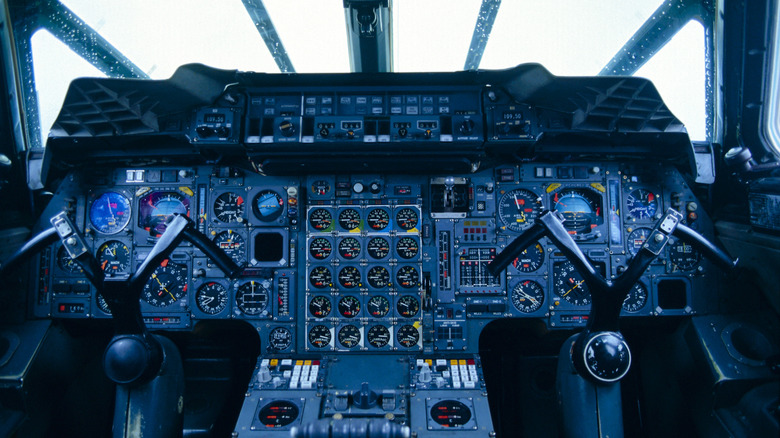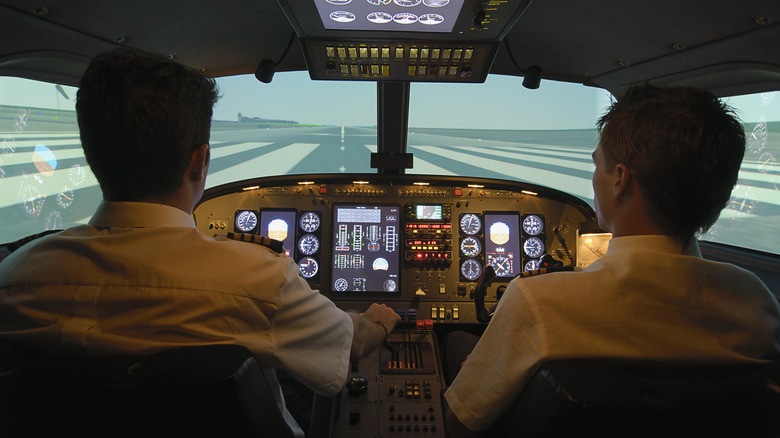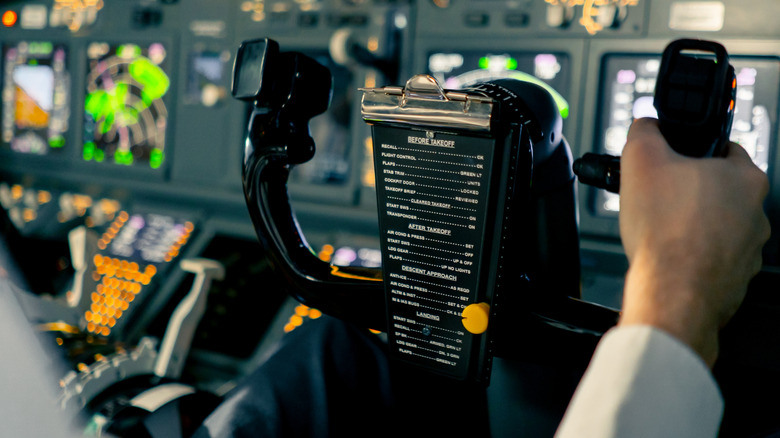Are Aircraft Cockpit Doors Bulletproof? Here's How Strong They Are
From the most iconic airplanes in aviation history to those among the forgotten passenger jets that once graced the skies, there's no denying that aircraft are incredible feats of engineering. These massive metal tubes with wings manage to transport people, cargo, and more across vast distances with little issue. Just as impressive as the technology that gets them off the ground is the level of safety packed into each model. After all, air travel, like any form of travel, can go wrong quickly, so keeping passengers and crew members protected should danger present itself is crucial.
If you've ever flown on a plane, there are some safety measures that you've undoubtedly encountered. Oxygen masks in the case of a drop in altitude, inflatable vests in the event the plane goes down into a body of water, and, of course, seatbelts to mitigate the effects of turbulence. One that isn't so obvious to the average passenger is the reinforcement of the cockpit doors for the protection of the pilots. In the modern era, aircraft cockpit doors can withstand blasts from small firearms and small explosives, making them bullet resistant but not quite bulletproof. This is to meet current International Civil Aviation Organization — member nations including the United States, China, and the United Kingdom, among others — regulations. For the past few decades, serious effort has gone into making cockpit doors as strong and forceful entry-proof as possible.
Cockpit doors have become increasingly reinforced throughout the years
The conversation around improving aircraft cockpit doors ramped up in the early 2000s, specifically following the September 11, 2001 attacks on the World Trade Center. Government officials and aircraft manufacturers alike set out to overhaul the existing door, turning it from a means of keeping the cabin quiet during flight into a defensive measure. To meet this new goal, cockpit doors have been redesigned so that just about every piece is as durable as possible, with a layered approach making these doors incredibly difficult for would-be attackers to get through.
Modern airplane cockpit doors are comprised of multiple layers. First is the outer layer, which is little more than thin vinyl covering the noise reduction layer and then a thick layer of Kevlar. This is what makes the door bullet and explosive-resistant, as well as resistant to around 1,500 lbs of battering force. To keep the door shut and locked, three electronic bolts slide securely into the frame of the aircraft with a manually enabled bolt along to the top for added protection. Keeping the door attached to the plane are reinforced hinges. If this doesn't seem like enough to keep pilots safe in an emergency situation, it should be said that protective efforts go beyond just the door and its hinges.
There's more to cockpit door reinforcement than strong materials and reinforced hinges
There are a few added elements that make cockpit doors much safer. One is a recent development that came to pass in 2023 after being discussed as a priority of the Biden-Harris Administration in 2021. Per Federal Aviation Administration guidelines, it's now required that commercial airline cockpits be fitted with a secondary barrier beyond the already hefty door. The idea is that this protects pilots during periods when the main door is opened. Unfortunately, this rule doesn't yet apply to preexisting aircraft, only new ones. This could change in the future should the Saracini Enhanced Aviation Act pass, requiring older planes be retrofitted with secondary barriers.
Another major innovation regarding cockpit safety is the complex locking and unlocking system that their doors have taken on. The doors can be opened via keypad with the entry of a security code and, in most cases, approval from the pilots within. Cockpit access has three modes: Normal where the door is locked but can be opened after 30 seconds if the pilots don't grant access, Unlocked for someone returning from the restroom, and Locked where the keypad becomes unusable and can't unlock the door. In an emergency situation where the pilot is incapacitated, an emergency code can be entered, allowing limited time to enter the cockpit.
It may have its risks, but with the continued advancement of cockpit door safety and the technology behind it, air travel is becoming safer than it ever has been. Hopefully in the future, it will only get safer and perhaps introduce some of the high-tech features we'd love to see in commercial airlines.


